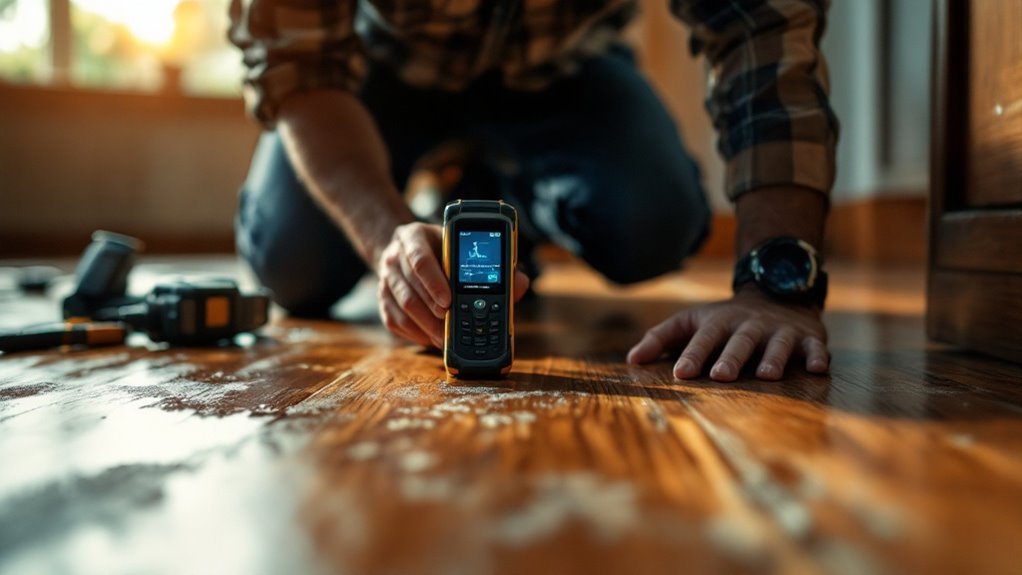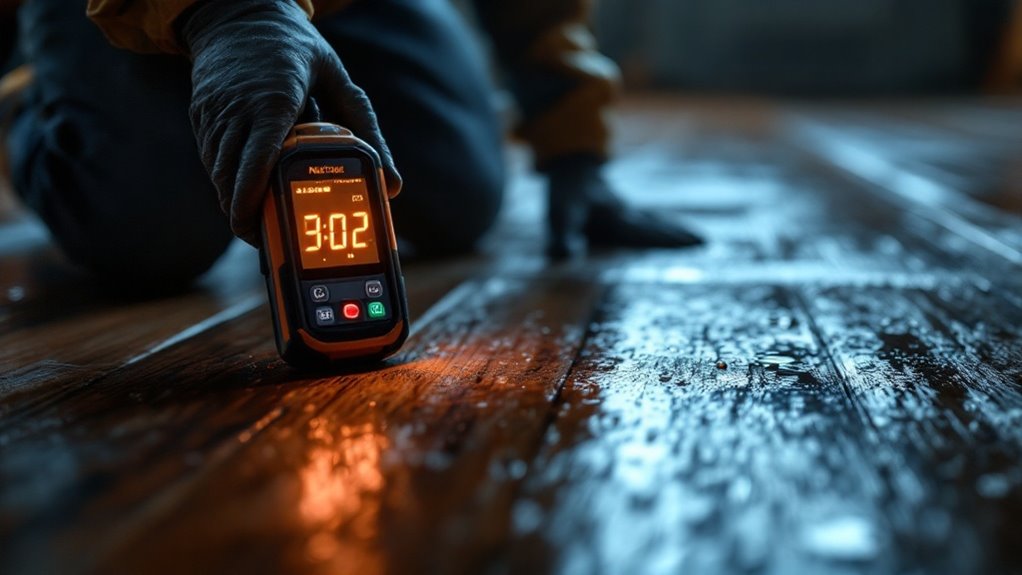You might think that if you can’t see water damage, it’s not a problem. Nevertheless, hidden water can wreak havoc on your property without you even realizing it. Restoration experts have specialized tools to uncover these issues before they escalate. From moisture meters to thermal imaging, these technologies reveal what’s lurking beneath the surface. Curious about how they work and what you can do to prevent costly damage? Let’s investigate the methods used to detect hidden water.
Key Takeaways
- Restoration experts use visual inspection techniques to identify signs of moisture, such as discoloration and musty odors in walls and floors.
- Moisture meters measure electrical resistance or capacitance to detect hidden water presence in materials like wood and drywall.
- Thermal imaging and infrared technology reveal temperature variations, helping to locate invisible moisture behind walls and under floors.
- Acoustic listening devices amplify sounds indicating water leaks, making it easier to pinpoint problem areas.
- Humidity sensors monitor moisture levels and alert experts to potential leaks before significant damage occurs.
Understanding the Importance of Water Detection

While you might take water for granted, its detection is crucial for various reasons, from agriculture to urban planning. Knowing where moisture lurks can help prevent costly damage and health risks associated with mold. In farming, detecting water levels guarantees crops receive the right amount, promoting healthy growth. In urban environments, identifying water leaks helps maintain infrastructure, saving on repairs and conserving resources. Furthermore, in residential settings, early detection can protect your home from hidden plumbing issues that might lead to significant problems later on. By understanding the importance of water detection, you’re not just safeguarding your property; you’re additionally contributing to environmental sustainability and efficient resource management. Embracing effective detection methods can make a substantial difference. Regular inspection of pipes for signs of wear is essential to prevent unnoticed leaks that could escalate into major issues.
Common Causes of Hidden Water Damage
Hidden water damage often stems from plumbing leaks and failures that can go unnoticed for long periods. You might additionally find issues with your roof and windows contributing to the problem, allowing moisture to seep in. Identifying these common sources is essential in preventing further damage to your home. Regular checks for moisture sources can help you catch these issues early before they escalate.
Plumbing Leaks and Failures
Have you ever wondered how plumbing leaks can go unnoticed, causing significant hidden water damage? Often, these leaks occur in walls, under floors, or behind appliances, making them hard to detect. Common culprits include worn-out seals, loose fittings, or corroded pipes. Even small leaks can lead to mold growth and structural damage over time. You might not notice water pooling until it’s too late. Regular inspections of your plumbing system can catch issues early. Listen for unusual sounds, check for damp spots, and monitor your water bill for unexpected increases. Taking proactive steps can save you from costly repairs and guarantee your home remains safe and dry. Don’t underestimate the importance of addressing plumbing problems quickly! Regular plumbing inspections can identify potential issues before they escalate into major emergencies.
Roof and Window Issues
Water damage can likewise stem from roof and window issues, leading to significant problems that may go unnoticed until it’s too late. Identifying these issues early can save you a lot of trouble down the line. Here are three common causes of hidden water damage:
- Damaged Shingles: Missing or cracked shingles can allow water to seep in and cause structural damage.
- Improper Sealing: Gaps around windows and doors can let moisture in, leading to mold growth and rotting wood.
- Blocked Gutters: Clogged gutters can cause water to overflow, leading to leaks in your roof and walls.
Being proactive about these potential problems can help you maintain a dry, healthy home.
Visual Inspection Techniques

When you’re searching for hidden water, visual inspection techniques can be incredibly helpful. You can check for surface moisture, utilize infrared thermal imaging, or even employ acoustic listening devices to detect leaks. Each method offers unique insights that can lead you to the source of the problem.
Surface Moisture Detection
While you might not always see it, surface moisture can greatly impact the integrity of structures and materials. To effectively detect surface moisture, consider these visual inspection techniques:
- Look for discoloration: Stains or dark spots on walls and ceilings can indicate moisture presence.
- Check for warping: Bending or bulging surfaces often signal underlying moisture issues.
- Smell for mustiness: A damp, moldy odor might suggest hidden water problems.
Infrared Thermal Imaging
Infrared thermal imaging is a powerful tool that can reveal hidden moisture issues not visible to the naked eye. This technology detects variations in temperature, allowing you to pinpoint areas where water may be present. By using thermal imaging, you can save time and resources in identifying potential problems before they escalate.
| Temperature Range | Moisture Indicator |
|---|---|
| 70°F – 80°F | Normal, no moisture issues |
| 60°F – 69°F | Potential moisture detected |
| 50°F – 59°F | High moisture presence |
| Below 50°F | Severe moisture issue |
With infrared thermal imaging, you’ll gain a clearer understanding of moisture-related challenges in your property, enabling proactive restoration efforts.
Acoustic Listening Devices
Acoustic listening devices offer an innovative approach to detecting hidden water damage, complementing visual inspection techniques. These devices amplify sounds that indicate water leaks, allowing you to identify problems that aren’t visible. Here’s how they work:
- Sensitivity: They pick up high-frequency sounds that might escape your ears, like dripping or rushing water.
- Precision: You can pinpoint the exact location of a leak, reducing unnecessary damage to walls or floors during repairs.
- Efficiency: By using these tools, you save time and resources, ensuring a faster restoration process.
Incorporating acoustic listening devices into your inspection toolkit can greatly improve your ability to find hidden water, making your restoration efforts more effective and thorough.
Moisture Meters: How They Work

Moisture meters are essential tools that help you detect the presence of water in various materials, from wood to drywall. These devices work by measuring the electrical resistance or capacitance of a material, which changes as moisture levels fluctuate. When you press the meter against a surface, it provides a reading that indicates whether there’s hidden moisture.
| Material | Typical Moisture Level |
|---|---|
| Dry Wood | 6-12% |
| Wet Wood | 20%+ |
| Drywall | 5-10% |
| Saturated Drywall | 15%+ |
Thermal Imaging Cameras: Revealing the Invisible
When you’re searching for hidden water, thermal imaging cameras can be a game-changer. These devices detect temperature variations, allowing you to spot moisture that’s otherwise invisible. Here’s how they can help you:
- Identify Temperature Differences: By showing cooler areas that may indicate water presence, thermal cameras pinpoint potential issues quickly.
- Locate Hidden Leaks: They reveal leaks behind walls or under floors, saving you from costly repairs.
- Assess Damage Extent: Thermal imaging helps evaluate the scope of water damage, guiding restoration efforts more effectively.
Using thermal imaging cameras not only speeds up the detection process but also improves your ability to tackle hidden water problems efficiently. With this technology, you’ll gain valuable insights and restore your space with confidence.
Infrared Technology in Water Detection
While traditional methods of water detection can be time-consuming, infrared technology offers a swift and accurate solution. This technology uses thermal imaging to identify temperature differences in surfaces, helping you spot hidden moisture behind walls or under floors. When water infiltrates an area, it cools the surrounding materials, creating a distinct temperature contrast that infrared cameras can easily detect. By analyzing these temperature variations, you can quickly locate leaks and assess the extent of water damage without invasive procedures. This not only saves you time but furthermore reduces the risk of further damage. Embracing infrared technology allows you to tackle water issues effectively, ensuring a safer and drier environment in your home or business.
The Role of Humidity Sensors
Humidity sensors play a crucial role in detecting and managing hidden water issues in your environment. By measuring moisture levels, these devices help you identify potential problems before they escalate. Here are three key benefits of humidity sensors:
- Early Detection: They alert you to increased humidity levels, allowing you to address leaks or water intrusion promptly.
- Prevent Mold Growth: By monitoring moisture, you can take preventive measures against mold, which thrives in damp conditions.
- Energy Efficiency: Keeping humidity in check can improve your HVAC system’s efficiency, leading to lower energy bills.
Incorporating humidity sensors into your space not only protects your property but also improves your overall comfort and health.
Professional Assessment and Remediation Processes
Understanding the extent of hidden water issues often requires a professional assessment, as these experts have the tools and knowledge to identify problems that may not be visible to the untrained eye. During the assessment, they’ll use advanced technology, like thermal imaging and moisture meters, to pinpoint moisture levels in walls, ceilings, and floors. Once they’ve identified the source of the water intrusion, they’ll create a remediation plan tailored to your specific situation. This plan may include water extraction, dehumidification, and repairs to prevent future issues. By addressing hidden water problems promptly, you can safeguard your home from mold growth and structural damage, ensuring a healthier living environment for you and your family. Trust the experts to tackle what you can’t see.
Conclusion
To sum up, detecting hidden water damage is essential for maintaining a safe and healthy living environment. Did you know that about 14,000 people in the U.S. experience a water damage emergency every day? By using advanced technologies like moisture meters and thermal imaging, restoration experts can quickly identify issues before they escalate. So, if you suspect water damage, don’t wait—getting a professional assessment can save you time, money, and a lot of stress in the long run.
